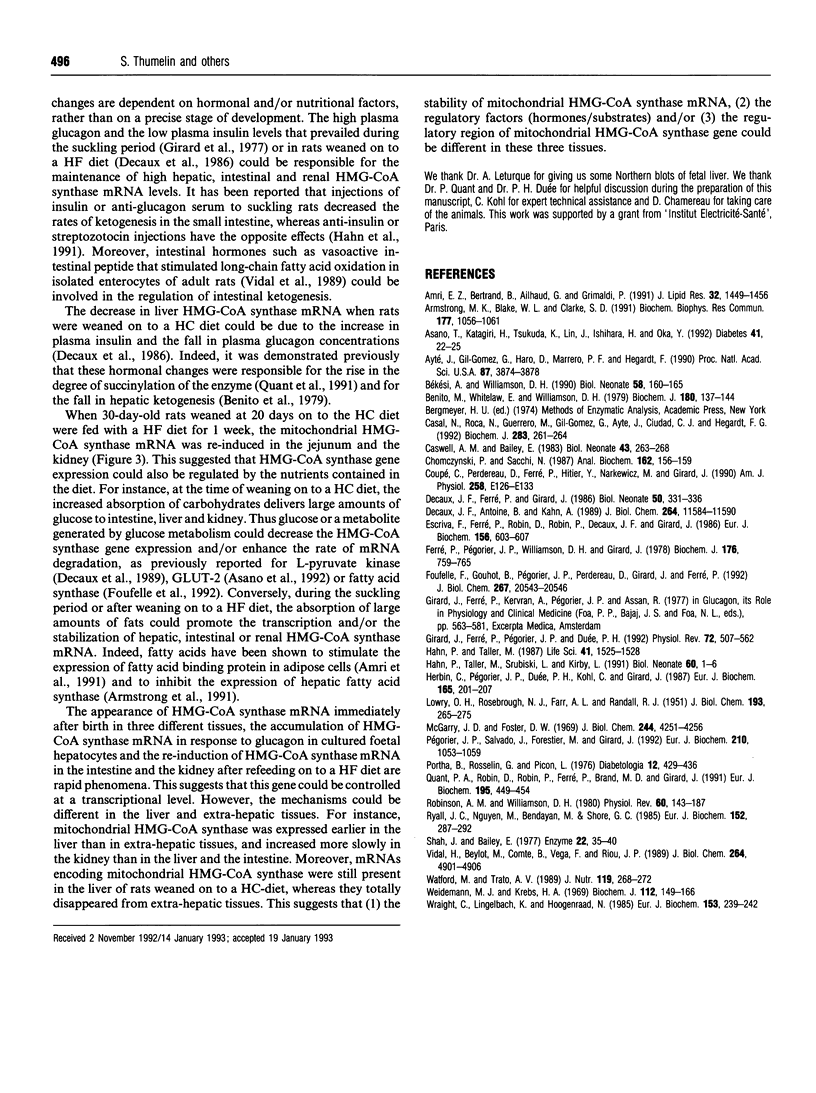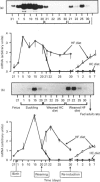Abstract
The tissue-specific expression of the mitochondrial 3-hydroxy-3-methylglutaryl-CoA (HMG-CoA) synthase gene was studied in 15-day-old suckling rats. The mRNA and protein were present in liver, intestine and kidney, but were absent from brain, heart, skeletal muscles, brown and white adipose tissues. Kidney-cortex mitochondria from suckling rats were able to produce low amounts of ketone bodies from oleate. Hepatic, intestinal and renal HMG-CoA synthase mRNA levels increased slowly during foetal life and markedly after birth. The postnatal increase in liver HMG-CoA synthase mRNA could be due to the increase in plasma glucagon levels, since it rapidly induced the accumulation of HMG-CoA synthase mRNA in cultured foetal hepatocytes. Hepatic, intestinal and renal HMG-CoA synthase mRNA levels remained elevated throughout the suckling period or in rats weaned on to a high-fat carbohydrate-free diet (HF), but decreased by 50% in the liver and totally disappeared from the intestine and the kidney of rats weaned on to a high-carbohydrate low-fat diet (HC). When HC-weaned rats were fed on a HF-diet for a week, HMG-CoA synthase mRNA was re-induced in the intestine and the kidney. The role of hormones and nutrients in the regulation of HMG-CoA synthase gene expression is discussed.
Full text
PDF



Images in this article
Selected References
These references are in PubMed. This may not be the complete list of references from this article.
- Amri E. Z., Bertrand B., Ailhaud G., Grimaldi P. Regulation of adipose cell differentiation. I. Fatty acids are inducers of the aP2 gene expression. J Lipid Res. 1991 Sep;32(9):1449–1456. [PubMed] [Google Scholar]
- Armstrong M. K., Blake W. L., Clarke S. D. Arachidonic acid suppression of fatty acid synthase gene expression in cultured rat hepatocytes. Biochem Biophys Res Commun. 1991 Jun 28;177(3):1056–1061. doi: 10.1016/0006-291x(91)90645-n. [DOI] [PubMed] [Google Scholar]
- Asano T., Katagiri H., Tsukuda K., Lin J. L., Ishihara H., Yazaki Y., Oka Y. Upregulation of GLUT2 mRNA by glucose, mannose, and fructose in isolated rat hepatocytes. Diabetes. 1992 Jan;41(1):22–25. doi: 10.2337/diab.41.1.22. [DOI] [PubMed] [Google Scholar]
- Ayté J., Gil-Gómez G., Haro D., Marrero P. F., Hegardt F. G. Rat mitochondrial and cytosolic 3-hydroxy-3-methylglutaryl-CoA synthases are encoded by two different genes. Proc Natl Acad Sci U S A. 1990 May;87(10):3874–3878. doi: 10.1073/pnas.87.10.3874. [DOI] [PMC free article] [PubMed] [Google Scholar]
- Benito M., Whitelaw E., Williamson D. H. Regulation of ketogenesis during the suckling-weanling transition in the rat. Studies with isolated hepatocytes. Biochem J. 1979 Apr 15;180(1):137–144. doi: 10.1042/bj1800137. [DOI] [PMC free article] [PubMed] [Google Scholar]
- Békési A., Williamson D. H. An explanation for ketogenesis by the intestine of the suckling rat: the presence of an active hydroxymethylglutaryl-coenzyme A pathway. Biol Neonate. 1990;58(3):160–165. doi: 10.1159/000243256. [DOI] [PubMed] [Google Scholar]
- Casals N., Roca N., Guerrero M., Gil-Gómez G., Ayté J., Ciudad C. J., Hegardt F. G. Regulation of the expression of the mitochondrial 3-hydroxy-3-methylglutaryl-CoA synthase gene. Its role in the control of ketogenesis. Biochem J. 1992 Apr 1;283(Pt 1):261–264. doi: 10.1042/bj2830261. [DOI] [PMC free article] [PubMed] [Google Scholar]
- Caswell A. M., Bailey E. Studies on rat hepatic mitochondrial hydroxymethylglutaryl-CoA synthase during the perinatal period. Biol Neonate. 1983;43(5-6):263–268. doi: 10.1159/000241653. [DOI] [PubMed] [Google Scholar]
- Chomczynski P., Sacchi N. Single-step method of RNA isolation by acid guanidinium thiocyanate-phenol-chloroform extraction. Anal Biochem. 1987 Apr;162(1):156–159. doi: 10.1006/abio.1987.9999. [DOI] [PubMed] [Google Scholar]
- Coupe C., Perdereau D., Ferre P., Hitier Y., Narkewicz M., Girard J. Lipogenic enzyme activities and mRNA in rat adipose tissue at weaning. Am J Physiol. 1990 Jan;258(1 Pt 1):E126–E133. doi: 10.1152/ajpendo.1990.258.1.E126. [DOI] [PubMed] [Google Scholar]
- Decaux J. F., Antoine B., Kahn A. Regulation of the expression of the L-type pyruvate kinase gene in adult rat hepatocytes in primary culture. J Biol Chem. 1989 Jul 15;264(20):11584–11590. [PubMed] [Google Scholar]
- Decaux J. F., Ferré P., Girard J. Effect of weaning on different diets on hepatic gluconeogenesis in the rat. Biol Neonate. 1986;50(6):331–336. doi: 10.1159/000242617. [DOI] [PubMed] [Google Scholar]
- Escriva F., Ferre P., Robin D., Robin P., Decaux J. F., Girard J. Evidence that the development of hepatic fatty acid oxidation at birth in the rat is concomitant with an increased intramitochondrial CoA concentration. Eur J Biochem. 1986 May 2;156(3):603–607. doi: 10.1111/j.1432-1033.1986.tb09620.x. [DOI] [PubMed] [Google Scholar]
- Ferré P., Pégorier J. P., Williamson D. H., Girard J. R. The development of ketogenesis at birth in the rat. Biochem J. 1978 Dec 15;176(3):759–765. doi: 10.1042/bj1760759. [DOI] [PMC free article] [PubMed] [Google Scholar]
- Foufelle F., Gouhot B., Pégorier J. P., Perdereau D., Girard J., Ferré P. Glucose stimulation of lipogenic enzyme gene expression in cultured white adipose tissue. A role for glucose 6-phosphate. J Biol Chem. 1992 Oct 15;267(29):20543–20546. [PubMed] [Google Scholar]
- Girard J., Ferré P., Pégorier J. P., Duée P. H. Adaptations of glucose and fatty acid metabolism during perinatal period and suckling-weaning transition. Physiol Rev. 1992 Apr;72(2):507–562. doi: 10.1152/physrev.1992.72.2.507. [DOI] [PubMed] [Google Scholar]
- Hahn P., Taller M. Ketone formation in the intestinal mucosa of infant rats. Life Sci. 1987 Sep 21;41(12):1525–1528. doi: 10.1016/0024-3205(87)90718-1. [DOI] [PubMed] [Google Scholar]
- Hahn P., Taller M., Srubiski L., Kirby L. Regulation of ketone formation and phosphoenolpyruvate carboxykinase activity in the small intestinal mucosa of infant rats. Biol Neonate. 1991;60(1):1–6. doi: 10.1159/000243382. [DOI] [PubMed] [Google Scholar]
- Herbin C., Pegorier J. P., Duee P. H., Kohl C., Girard J. Regulation of fatty acid oxidation in isolated hepatocytes and liver mitochondria from newborn rabbits. Eur J Biochem. 1987 May 15;165(1):201–207. doi: 10.1111/j.1432-1033.1987.tb11212.x. [DOI] [PubMed] [Google Scholar]
- LOWRY O. H., ROSEBROUGH N. J., FARR A. L., RANDALL R. J. Protein measurement with the Folin phenol reagent. J Biol Chem. 1951 Nov;193(1):265–275. [PubMed] [Google Scholar]
- McGarry J. D., Foster D. W. Ketogenesis and cholesterol synthesis in normal and neoplastic tissues of the rat. J Biol Chem. 1969 Aug 10;244(15):4251–4256. [PubMed] [Google Scholar]
- Pegorier J. P., Salvado J., Forestier M., Girard J. Dominant role of glucagon in the initial induction of phosphoenolpyruvate carboxykinase mRNA in cultured hepatocytes from fetal rats. Eur J Biochem. 1992 Dec 15;210(3):1053–1059. doi: 10.1111/j.1432-1033.1992.tb17511.x. [DOI] [PubMed] [Google Scholar]
- Portha B., Rosselin G., Picon L. Postmaturity in the rat: impairment of insulin, glucagon, and glycogen stores. Diabetologia. 1976 Oct;12(5):429–436. doi: 10.1007/BF01219505. [DOI] [PubMed] [Google Scholar]
- Quant P. A., Robin D., Robin P., Ferre P., Brand M. D., Girard J. Control of hepatic mitochondrial 3-hydroxy-3-methylglutaryl-CoA synthase during the foetal/neonatal transition, suckling and weaning in the rat. Eur J Biochem. 1991 Jan 30;195(2):449–454. doi: 10.1111/j.1432-1033.1991.tb15724.x. [DOI] [PubMed] [Google Scholar]
- Robinson A. M., Williamson D. H. Physiological roles of ketone bodies as substrates and signals in mammalian tissues. Physiol Rev. 1980 Jan;60(1):143–187. doi: 10.1152/physrev.1980.60.1.143. [DOI] [PubMed] [Google Scholar]
- Ryall J., Nguyen M., Bendayan M., Shore G. C. Expression of nuclear genes encoding the urea cycle enzymes, carbamoyl-phosphate synthetase I and ornithine carbamoyl transferase, in rat liver and intestinal mucosa. Eur J Biochem. 1985 Oct 15;152(2):287–292. doi: 10.1111/j.1432-1033.1985.tb09196.x. [DOI] [PubMed] [Google Scholar]
- Shah J., Bailey E. Changes in the activities of the enzymes of hepatic ketogenesis in the rat between late fetal life and weaning. Enzyme. 1977;22(1):35–40. doi: 10.1159/000458505. [DOI] [PubMed] [Google Scholar]
- Vidal H., Beylot M., Comte B., Vega F., Riou J. P. Vasoactive intestinal peptide stimulates long-chain fatty acid oxidation and inhibits acetyl-coenzyme A carboxylase activity in isolated rat enterocytes. J Biol Chem. 1989 Mar 25;264(9):4901–4906. [PubMed] [Google Scholar]
- Watford M., Tatro A. V. Phosphoenolpyruvate carboxykinase of rat small intestine: distribution and regulation of activity and mRNA levels. J Nutr. 1989 Feb;119(2):268–272. doi: 10.1093/jn/119.2.268. [DOI] [PubMed] [Google Scholar]
- Weidemann M. J., Krebs H. A. The fuel of respiration of rat kidney cortex. Biochem J. 1969 Apr;112(2):149–166. doi: 10.1042/bj1120149. [DOI] [PMC free article] [PubMed] [Google Scholar]
- Wraight C., Lingelbach K., Hoogenraad N. Comparison of ornithine transcarbamylase from rat liver and intestine. Evidence for differential regulation of enzyme levels. Eur J Biochem. 1985 Dec 2;153(2):239–242. doi: 10.1111/j.1432-1033.1985.tb09292.x. [DOI] [PubMed] [Google Scholar]





